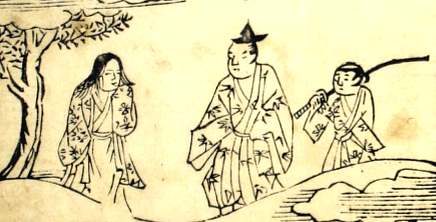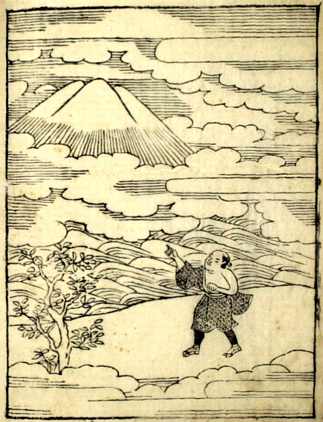Ise, schmise
My post in February about online scans of the Ise monogatari led to Brian's detailed post about mana as well as a great MetaFilter thread courtesy of Languagehat.

LOL pointy boats
Minor MeFi drama broke out when someone accused us of using the pictures in the books as the raw material for cheap gags instead of respecting them for their place in art history &c. &c. To see my sinister plot so perilously near discovery terrified me, and I had already shredded half of my records when Mr Hat and his shadowy allies reappeared to distract the whistleblower with oily sophistry about respecting and mocking the art at the same time. I was safe -- but everyone knows that Mr Hat's assistance always has a price...
Seriously, enjoying art from different perspectives is not a new phenomenon, nor one exclusive to cultural outsiders. The Ise monogatari itself has been revered and ridiculed in equal measure for centuries, and the glorious exemplar of that tradition is also available at Waseda: the Nise monogatari (仁勢物語), freely romanizable as Tales of Schmise.*.
The Tales of Schmise, written in the mid-1600s by an unknown author (traditionally KARASUMARU Mitsuhiro, but modern scholarship says probably not), is a parody of the Tales of Ise as meticulous as it is juvenile. Every chapter in Ise has a corresponding chapter in Schmise which follows it in structure and sound as closely as possible while cruelly warping all the details.
Greedy slobs replace sensitive gallants, beautiful maidens become withered crones, and all the vignettes revolve around food, cowardice, farting, skin disease, or some other charming topic. Equivalents in the modern Anglosphere might include Mad magazine's scene-by-scene movie parodies (I was tempted to translate the title Tales of I-blecchh!), or that sub-genre of cinema wherein self-aware comic dialogue is dubbed over corny old movies.
For example, here's the 2nd chapter of Ise (with modernized pronunciation, etc.), with quick-and-literal translation:
Mukashi, otoko arikeri. Nara no kyō wa hanare, kono kyō wa hito no ie mada sadamarazarikeru toki ni, nishi no kyō ni onna arikeri. Sono onna, yohito ni wa masarerikeri. Sono hito, katachi yori wa kokoro nan masaritarikeru. Hitori no mi mo arazarikerashi. Sore o, kano mame-otoko, uchi-monogataraite, kaeri-kite, ikaga omoiken, toki wa Yayoi no tsuitachi, ame sobofuru ni yarikeru:
Oki mo sezu/ ne mo sede yoru o/ akashite wa/ haru no mono to te/ nagame-kurashitsu
Long ago, there was a man. After Nara had been abandoned as a capital, but before many people had made homes in the new one, there was a woman who lived on the west side. She was lovelier than all others. Her heart was lovelier than her face. But she didn't live alone. Our earnest man spoke kindly to her, then went home: how did he feel? It was the first day of Yayoi, the third month, and as the rain gently fell, he sent her this poem:
Neither rising/ nor sleeping, I pass/ the night, and/ thinking "Here is spring",/ stare [at the rain] all day
And here's the corresponding chapter in Schmise:
Okashi, otoko arikeri. Nara no kyō wa hanare, kono kyō wa mada yado mo sadamarazarikeru toki ni, nishi no kyō ni te onna o mochikeri. Sono onna, yo no hito ni wa togarerikeri. Sono hito, katachi yori wa kokoro nan kowakarikeri. Hito no yō ni mo arazarikerashi. Sore o, kano otoko, uchi-kataraite, ikaga omoiken, toki wa Yayoi no tsuitachi, ame sobofuru ni yomeru.
Oki mo sezu/ ne mo sede yoru mo/ mata hiru mo/ myō na kao to te/ nagame-kurashitsu
Funny! There was a man. After Nara had been abandoned as a capital, but before there was much in the way of accomodation in the new one, he had a woman who lived on the west side. She was worse than any other. Her heart was scarier than her face. She didn't even seem human. Our man spoke kindly to her: how did he feel? It was the first day of Yayoi, the third month, and as the rain gently fell, he read this poem:
Neither rising/ nor sleeping, "By night/ or by day," I think,/ "That face is strange",/ and stare [at it] all day

The insult gags are obvious even in English. On the other hand, the opening okashi ("funny, goofy, strange") is an absurdist move, impossible to translate because it is an entirely sound-based riff on mukashi, which famously opens (almost) every chapter in the Ise.
You see, Schmise is clearly mocking the fragile, weepy nobles portrayed in the Ise -- but on the other hand, if you don't know the original Ise really well, the Schmise is just a collection of labored shaggy dog stories and poetry that, even by pun-happy Japanese standards, is truly abominable. For this book to work, you have to know the target, love the target, and be willing to laugh at it, all at once. And plenty of people fit that description; the book was very popular. (Waseda even has another copy online.)
Some people mistakenly believe that art is Serious Business, or was until quite recently, and that our ancestors gaped with unwavering awe at the gradually expanding canon until modern (or postmodern) literary theory arrived to set humanity free. But the fact is, humans have always been human, and they've always liked jokes about taboos and humiliation. Art thrives because of good-natured ribbing, not despite it. The Tales of Ise can take care of themselves.
As final proof that nothing is sacred, here's the hero pointing out the close resemblance between Mt Fuji itself and a tasty rice ball:

(If you've read this far, you might also be interested to know that there are several excellent scholarly editions of the work, including my favorite, edited by KOBAYASHI Shōjirō (小林祥次郎), which has the original Tales of Ise set in parallel at the bottom of the page for comparison. No pictures, though.)
![[No-sword]](http://no-sword.jp/images/site/no-sword_banner.jpg)


